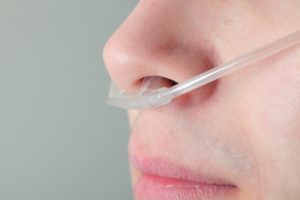Oxygen therapy is commonly prescribed for patients with pulmonary fibrosis (PF). The therapy is used to treat low levels of oxygen in the blood, which is caused by scarring in the lungs. The scarring inhibits the transfer of oxygen and carbon dioxide to and from the body. A steady flow of pure oxygen increases the concentration of oxygen in the lungs and elevates oxygen levels in the bloodstream.
Benefits of oxygen therapy for PF patients
While oxygen therapy does not directly address the underlying cause of pulmonary fibrosis or halt the progression of the disease, it is an important therapy that improves symptoms and organ function. Many debilitating symptoms associated with PF can be traced back to low levels of oxygen in the blood, including breathlessness, shallow breathing, sleep disorders, fatigue, and even weight loss. Oxygen therapy is used to elevate blood oxygen levels and normalize breathing. Improved breathing leads to improvements in related secondary symptoms that impact quality of life.
 How oxygen therapy is administered
How oxygen therapy is administered
Oxygen therapy can be cumbersome and life-altering, but physicians believe that its use far outweighs its inconvenience — and technological efforts are being made to make oxygen therapy equipment more mobile.
Here’s how it works: Oxygen is moved into the lungs through a thin breathing tube that wraps around the ears and is placed in the nostrils. The tube is attached to an oxygen tank that flows pure oxygen into the nostrils. The oxygen combines with the patient’s breath as they inhale.
Sizes of oxygen tanks vary. Often, patients who need oxygen therapy for 15 hours or more use a large oxygen tank at home and a small travel tank when they socialize or run errands outside of their home. Some portable oxygen tanks are very small and offer only a limited amount of oxygen, which can cut short the PF patients’ travel range.
Newer technologies, such as oxygen cylinders, hold more gas and extend the duration of the supply. They work by administering the oxygen via a pulse dose that only emits at the moment the user breathes in. Cylinders are bulkier than portable oxygen containers but are light-weight and can be carried in a backpack or rolling travel bag.
Oxygen concentrators are another next-generation alternative to large oxygen tanks used at home. Different from a tank — which can be difficult to move around, pose a fire hazard (pure oxygen is combustible), and eventually run out — an oxygen concentrator pulls concentrated oxygen out of existing air which allows unlimited use. Extra-long air tubes can be attached to the unit so it can be placed in low-profile areas of the home.
Note: Pulmonary Fibrosis News is strictly a news and information website about the disease. It does not provide medical advice, diagnosis, or treatment. This content is not intended to be a substitute for professional medical advice, diagnosis, or treatment. Always seek the advice of your physician or other qualified health provider with any questions you may have regarding a medical condition. Never disregard professional medical advice or delay in seeking it because of something you have read on this website.
______________________________
